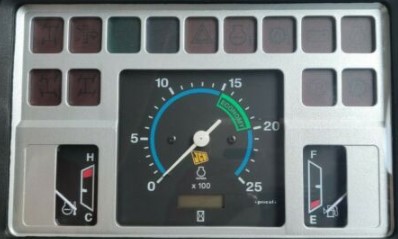When operating a Jcb Loader, it’s essential to know the different warning lights and symbols that may appear on the dashboard. They can indicate something as simple as a low fuel level or something more serious such as an engine malfunction. In this article, we will discuss the various warning lights and symbols that you may see on your Jcb Loader dashboard. We’ll break them down into categories so you can quickly identify which light means what and how to respond to it. Read on to learn how to stay safe when operating your Jcb Loader.
Recommended article: Isuzu Truck Dashboard Warning Lights Symbols
JCB Loader Dashboard Warning Lights

The JCB Loader Dashboard Warning Lights And Symbols can be found on the instrument panel of your loader. These warning lights notify the operator of potential hazards, failure conditions, or maintenance needs.
It is essential to be familiar with the meaning of each warning light and the recommended course of action to take if one should illuminate while you are operating the loader.
⚡️ Another article: How To Turn Off Dashboard Warning Lights
The following is a list of the JCB Loader Dashboard Warning Lights And Symbols, along with a brief description of each:
- Oil Pressure Warning Light: This light indicates low engine oil pressure. If this light comes on, you should check the oil level and add oil if necessary. If the light remains on after adding oil or the engine oil pressure is still low, shut down the engine and contact a qualified technician for further diagnosis.
- Water Temperature Warning Light: This light comes on when the engine coolant temperature is too high. If this happens, stop the engine immediately and let it cool down before continuing the operation. If the light remains on after the engine has cooled down, shut down the engine and contact a qualified technician for further diagnosis.
- Battery Charge Warning Light: This light comes on when the battery is not properly charged. A malfunctioning alternator or voltage regulator could cause this. If this light comes on, you should shut down the engine and have the electrical system checked by a qualified technician.
See also: Mahindra Bolero Dashboard Warning Lights
JCB Loader Dashboard Symbols

Many different symbols can be found on the dashboard of a JCB loader. Here is a list of some of the most common ones and what they mean:
- Amber Engine Warning Light: This light indicates that there is an issue with the engine, and it needs to be checked by a mechanic.
- Red Coolant Temperature Warning Light: This light means that the coolant temperature is too high, and the engine is at risk of overheating.
- Yellow Fuel Level Warning Light: This light comes on when the fuel level in the tank is low.
- Red Battery Voltage Warning Light: This light indicates that the battery voltage is low and needs to be charged.
See also: Mahindra Scorpio Engine Warning Light
Knowing the meaning of warning lights and symbols on your JCB loader dashboard can help you stay safe and in control. It’s important to know which lights are showing up, what they mean, and when it is time to take action. Pay close attention to your dashboard as you drive so that you don’t miss any warning signs or potential risks. When in doubt, check with a qualified technician for more information about safely operating your equipment.
⚡️Other article: Infiniti Qx60 Dashboard Warning Lights
FAQs About Jcb Loader Dashboard Warning Lights And Symbols
What do the warning lights on my dashboard mean?
When a green or blue light is illuminated, this indicates that the system is on and operating. Whereas an orange/yellow warning light typically means that servicing or repair of the vehicle should be carried out soon. This level of urgency is less urgent than if a red light appears alongside a flashing one, in which case immediate action should be taken.
What does the yellow exclamation mark in brackets mean on the dashboard?
When the dashboard illuminates a symbol consisting of an exclamation mark in a circle, bracketed on either side, it indicates that the brake fluid level is low. It is essential to take notice and address this issue immediately; failure to do so may result in reduced braking performance or complete loss of the braking system.

